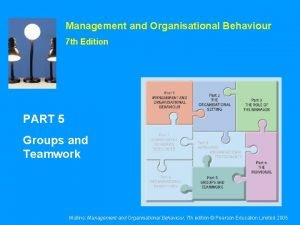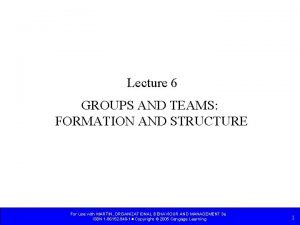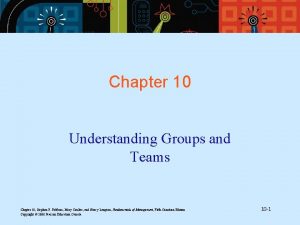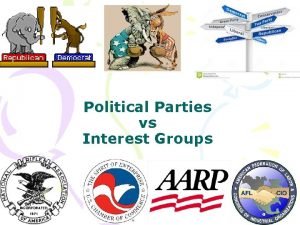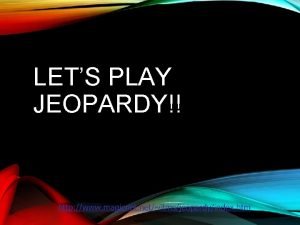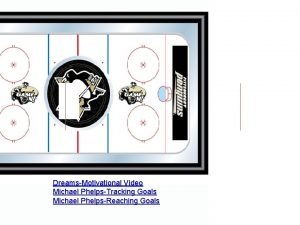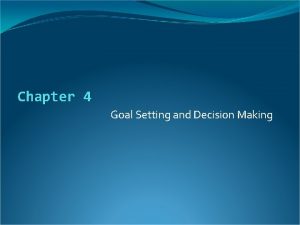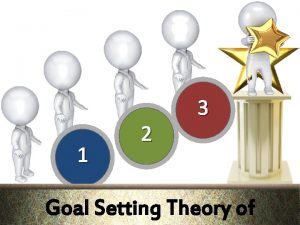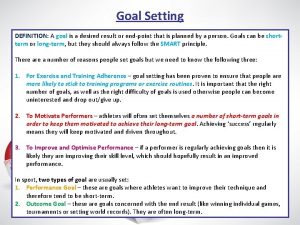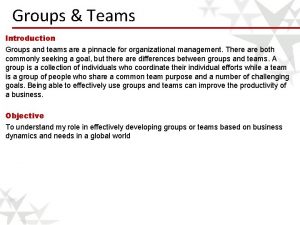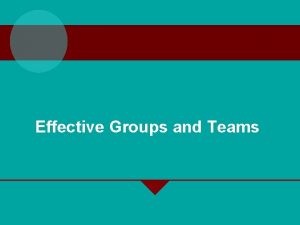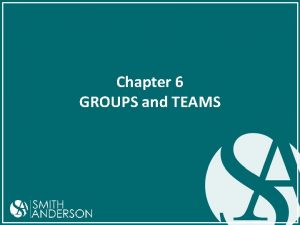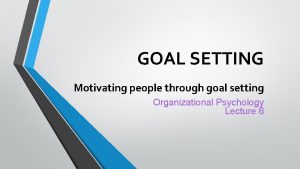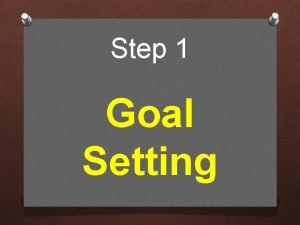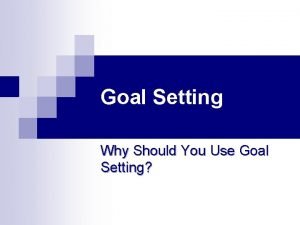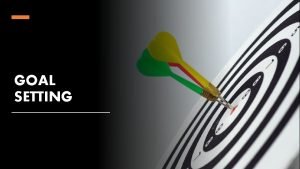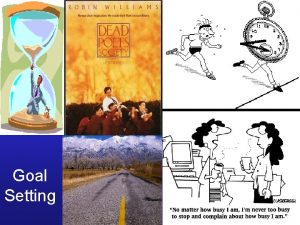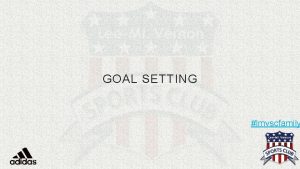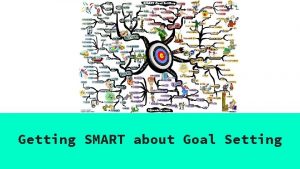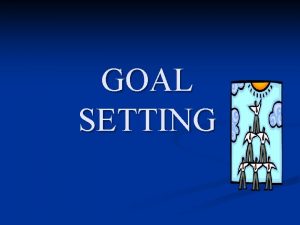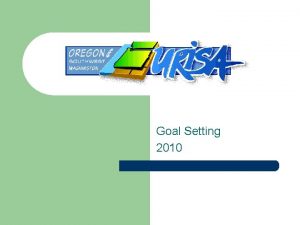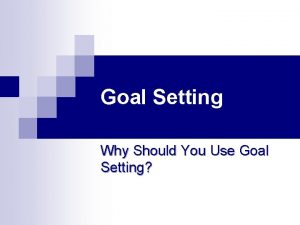Goal setting in sports performance Groups teams Teams























- Slides: 23

Goal setting in sports performance

Groups & teams • Teams operate in groups. • Spectators in groups. • It is important to understand how and why people work together, in order to maximise performance of all within the team. • The process between the group and within the groups is called group dynamics. • The relationships within a group are extremely complex because of the internal and external influence on group performance.

Groups/sports team formation • Tuckman 1965 1 – Forming 2 – Storming 3 – Norming 4 – Performing

Team cohesion Festinger 1963 – Cohesiveness if the total field of forces which act on members to remain in the group. Cohesion concerns the motivation which attracts individuals to the group and the resistance of those members to the group breaking up. Carron 1980 – two dimensions of cohesion 1 - Group integration; how individual members of the group feel about the group as a whole. 2 - Individual attraction to the group; how attracted the individuals are to the group.

Team cohesion Example – RSA Rugby 1995 RWC Winners Made up of individuals wo had a high regard for all other members of the ream and who resisted any break-up o the team after the competition finished.

Group/sports team performance Bringing the best individuals together will increase the chances of you having the best team. Steiner 1972 model Actual productivity = potential productivity – loses due to faulty processes.

Group/sports team performance Actual productivity = potential productivity – loses due to faulty processes. PP = best possible performance of the group, taking into account resources available, and abilities of individual team members. LDFP = 1 – Co-ordination problems; if co-ordination and timing of team members do not match, team strategies that depend on them will suffer, and therefore so will team performance. 2 – Motivation problems; if individual members of a team are not motivated to the same extent, they will be pulling in different directions and the potential of the team will not be realised. E. g. Playing netball, some play to win, some play to be with friends.

The Ringelmann effect The average individual performance decreases as the group size increases. Rope pulling task, identified that groups pulled with more force that individuals, however each individuals pulling forces was greater. Eight people pulled only as hard as four times as hard as one, not eight times as hard. Ingham (1974) showed that this loss in performance was due to both coordination and motivational problems, but was mainly caused by individuals within the group losing motivation. Social loafing – when some individuals lose motivation, when their efforts may not recognised or group identity is disppearing.

The Ringelmann effect Social loafing – when some individuals lose motivation, when their efforts may not recognised or group identity is disappearing. Social loafing is undesirable in teams and should be eliminated as far as possible. If lack of team identity is the reason what could you do ? To cut down on losses in team performance due to co-ordination difficulties, you should select people based on their interactive skills. It should be emphasised that good co-ordination will eventually lead to better performance. Games using smaller teams may help to co-ordinate the actions of different sets of players within a team.

Goal setting is used to increase a performers motivation, confidence and persistence on task. E. g training or developing skills. Participants in sport are often faced with complex and threatening situation and may feel anxious. Goal setting can help to alleviate this anxiety by controlling arousal and ultimately to enhance performance. Goal setting is used to increase attentional focus and to help to monitor performance.

Four ways goal setting can be used to affect performance. 1 – By directing attention 2 – By regulating the amount of effort put into a given task. 3 – Ensuring effort is sustained until the goal is reached. 4 – By motivating people to develop a variety of strategies to reach their goal

SMART goal setting. S M A R T

SMART goal setting. Specific Measurable Achievable Recorded Time phased

Types of goals Outcome goals Performance goals Process goals

Types of goals Outcome goals – goals that are targets directed towards an end result of the activity eg. Wanting to win a netball match. Performance goals – goals that are directed towards the individual's end performance eg. Improve my batting average in cricket. Process goals – goals that are used to improve a skill and are often related to technique eg. Improve my batting technique in cricket.

Types of goals Other factors affecting goal setting Long term goal is a progressive process and must start with achieving a short term goal. Short term goal provide a greater opportunity for success, which can reinforce positive feelings and in turn help control anxiety levels. Many athletes use realistic target dates to help them achieve their shortterm goals.

Effective goal setting There must be a breakdown of the overall goals that you want to achieve for goal setting to be effective. Eg. To win the league, the team may have to concentrate on winning more games away from home. For this to be achieved there may be short-term goals of improving the attacking of the team. It can be more motivating to split long term goals into medium term and short term goals which are more specific and manageable over a short period of time.

Sharing decision-making Goals that are set through negotiation and agreement are far more effective than externally set goals. The participant will have a sense of ownership over the goal setting and will be better motivated to achieve. Goal setting is also likely to be fairer and more realistic if all parties involved have an input.





 Group and team difference
Group and team difference Groups and teams difference
Groups and teams difference Groups and teams difference
Groups and teams difference Understanding groups and managing work teams
Understanding groups and managing work teams Understanding groups and teams
Understanding groups and teams Understanding groups and teams
Understanding groups and teams How are ethnic groups and religious groups related
How are ethnic groups and religious groups related Fundamental goal of interest groups
Fundamental goal of interest groups Outdoor sports name
Outdoor sports name Professional goal ttess
Professional goal ttess Agile goal setting
Agile goal setting Effective communication jeopardy
Effective communication jeopardy Goal setting theory
Goal setting theory Objectives of goal setting
Objectives of goal setting Michael phelps goal setting
Michael phelps goal setting Christian goal setting
Christian goal setting Short term goals for teenagers
Short term goals for teenagers Managerial planning and goal setting
Managerial planning and goal setting Decision making goal setting
Decision making goal setting Goal setting theory
Goal setting theory Locke and latham 1990
Locke and latham 1990 Goal setting slides
Goal setting slides A goal is a result that is desired
A goal is a result that is desired Doing goal setting on the last day before gspeed freezes
Doing goal setting on the last day before gspeed freezes
